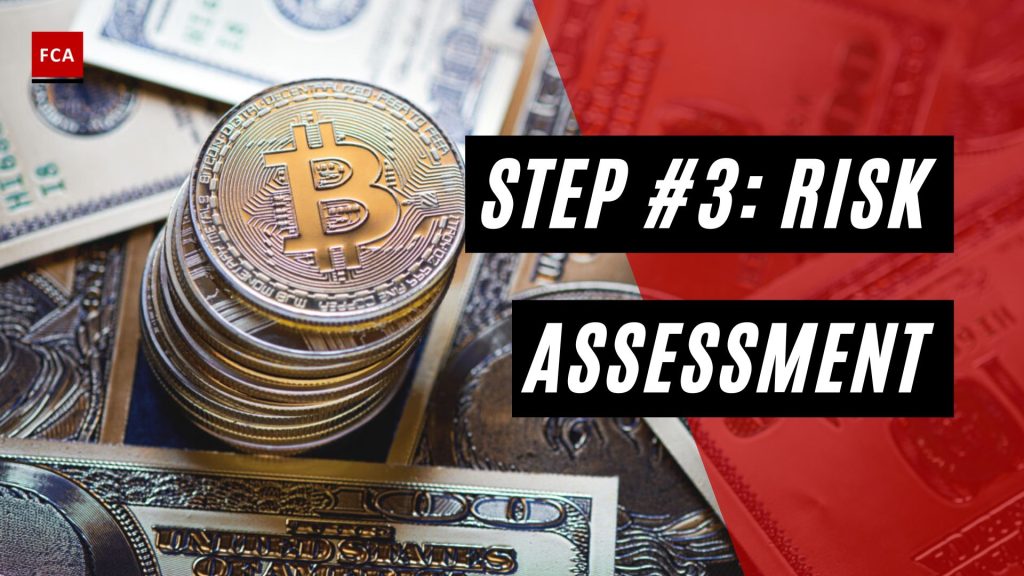Risk assessment is a crucial process that allows organizations to proactively identify and mitigate potential vulnerabilities, allocate resources effectively, and safeguard against financial crime risks in the realm of cryptocurrencies.
Cryptocurrencies have witnessed successful efforts to curb their utilization for financial crime. To ensure your company doesn’t inadvertently facilitate illicit activities, it is crucial to have robust systems, controls, and procedures in place. This is where cryptocurrency risk assessment becomes paramount. By conducting a risk assessment tailored to your business, you can comprehend potential impacts and take preventive measures.

Types of Risk Assessments
Risk assessments are performed periodically at different levels, including annual, ad-hoc, or continuous monitoring of customers. Here are three common risk assessment types:
- Enterprise Risk Assessments: Conducted annually, these assessments identify major risk categories such as system risks, cyber security risks, operational risks, fraud risks, HR risks, market risks, financial risks, and regulatory risks. Each category is further broken down to determine the specific exposure.
- Financial Crime Risk Assessments: These annual assessments primarily focus on money laundering risks. They scrutinize customer geography, customer types, offered products, and distribution channels.
- Customer Risk Assessments: This type of assessment calculates risk scores for customers using various criteria such as geography, customer type, customer activity, and blockchain or cryptocurrency transaction history.
Benefits of Risk Assessments
Cryptocurrency risk assessments offer several benefits in developing and enhancing anti-financial crime frameworks in the cryptocurrency sphere:
- Mapping Vulnerabilities: Risk assessments proactively identify potential vulnerabilities, enabling you to address them before regulatory, civil, or criminal scrutiny arises. Understanding how criminals might exploit specific products or services is vital.
- Resource Planning: Once vulnerabilities are identified, you can determine the controls needed to mitigate them. This risk-based approach allows you to devise effective strategies and allocate scarce resources appropriately. Questions like “Which external tools are worth investing in?” and “What skills do our AML analysts need?” help optimize resource allocation.
- Development Strategy: In the fast-paced cryptocurrency sector, growth and innovation are constant endeavors. Risk assessments guide decision-making, such as determining which new coins to list on exchanges. Leveraging risk assessment insights aids organizational development efforts.
- Evolving Dialogue: Risk assessments should facilitate ongoing dialogue, reflecting insights and feedback from senior management, auditors, consultants, and stakeholders. Regular updates, ideally annually, ensure relevance and accommodate evolving perspectives.
Key Components of Cryptocurrency Financial Crime Risk Assessment
A comprehensive cryptocurrency risk assessment should cover five key risk areas: customers, products, transactions, geographies, and delivery channels.
- Customer Risk: Understand customer risk by examining transaction types and volumes. Risk profiles can be evaluated at both individual and cluster levels, with clusters referring to group addresses associated with customers.
- Product Risk: Evaluate risks associated with specific crypto assets, considering factors such as storing private keys or facilitating transfers.
- Transaction Risk: Analyze blockchain data to establish transaction risks. While information for cryptocurrencies like Bitcoin is readily available, others like Monero pose challenges in obtaining transaction details.
- Geographical Risk: Consider the geographic factors related to customer location or the base of operations for specific cryptocurrencies or exchanges.
- Delivery Channel Risk: Understand the risks associated with various delivery channels, including online platforms, banks with cryptocurrency exposure, or crypto ATM providers.
To ensure the effectiveness of a risk assessment, it should be specific to your business and presented in a suitable format. For instance, using an Excel spreadsheet to document risk calculations and highlight areas of high risk simplifies tracking and facilitates regulatory compliance.

Geographical and Delivery Channel Risks
Geographical risk is a common factor to consider in assessing financial crime risks. It relates to the location of your customers. If you’re dealing with cryptocurrencies other than Bitcoin or Ethereum, understanding where the crypto asset was invented and where it is based becomes important. This knowledge is crucial when establishing relationships with crypto exchanges or onboarding new customers, especially for banks and over-the-counter traders.
Additionally, delivery channel risk must be understood. Whether your company operates solely online, is a cryptocurrency-exposed bank, or a provider of crypto ATMs, each delivery channel poses distinct risks that require careful consideration.
Key Elements of Risk Assessments
Once you have identified the key risk areas and determined where to focus your efforts, certain elements should be kept in mind during the risk assessment process:
- Specificity: Risks discussed in the assessment should be specific to your business, aligning with your anti-financial crime framework. Tailoring the assessment to your organization ensures relevance and effectiveness.
- Format: The risk assessment should be presented in a logical and sensible format. Consider using tools like Excel spreadsheets to document risk calculations and highlight areas of significant concern. This approach aids in tracking and helps regulators comprehend the assessment.
- Scenario Analysis: Assess financial crime risks across multiple scenarios by evaluating the likelihood of risks and their potential impact on your business. This analysis enables a comprehensive understanding of the threats posed and helps prioritize mitigation efforts.
- Controls Assessment: It is crucial to address the controls in place to mitigate risks and assess their effectiveness. Merely stating that systems and controls exist is insufficient if they do not effectively mitigate the identified risks. Evaluating controls allows for a more accurate assessment of residual risk.
Financial Crime Risk Categories
Within the risk areas, certain financial crime risk categories deserve attention:
- Customer Risks: Non-face-to-face customer onboarding presents inherent risks. While various vendors offer customer authentication and Know-Your-Customer (KYC) solutions, a degree of risk remains. Verifying document authenticity with 100% accuracy and ensuring customers’ identity claims are valid is challenging. Balancing robust mitigating measures with organizational feasibility and user-friendliness poses a significant challenge.
- Transaction Risks: Cryptocurrency transactions operate differently from SWIFT transactions in the fiat world. The absence of remitter and beneficiary information poses challenges in identifying transaction origins and destinations. Precise comprehension of cryptocurrency mechanics is crucial to mitigate transaction risks effectively.
- Product or Service Risks: Fraud risk is prevalent in the realm of cryptocurrencies and blockchain, particularly targeting vulnerable customers unfamiliar with these technologies. Criminals often entice victims with promises of lucrative gains. It is essential to educate customers and ensure they understand the nature of their transactions to prevent falling victim to such schemes.
An Example of Cryptocurrency Risk Assessment
During a risk assessment, consider a scenario where a customer falls victim to a scam and uses cryptocurrencies for scam-related payments. Given the prevalence of crypto scams, the likelihood of this scenario is relatively high. The impact can be considered moderate.
Next, calculate the inherent risk of this scenario. Suppose it is determined to be medium risk. As an organization, you must be aware of these risks and have systems and controls in place to prevent such incidents. Controls could involve capturing client information, monitoring or blocking deposits to high-risk wallets, and implementing transaction monitoring rules and limits. These measures can significantly mitigate the risk. Considering these controls, the inherent risk may be reduced to a low or medium residual risk, depending on the specific risk model employed.

Final Thoughts
Assessing financial crime risks across multiple scenarios, evaluating control effectiveness, and calculating residual risk based on mitigation measures are critical steps. By conducting a thorough cryptocurrency risk assessment and integrating its findings into your anti-financial crime framework, you can safeguard your organization and maintain integrity within the cryptocurrency realm.
By conducting a thorough cryptocurrency risk assessment and implementing effective measures, organizations can proactively address vulnerabilities, allocate resources wisely, and safeguard against financial crime risks in the cryptocurrency sphere.









